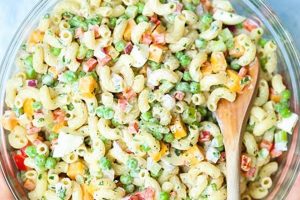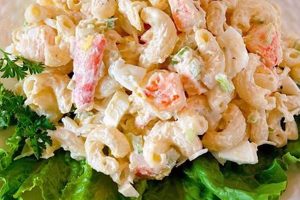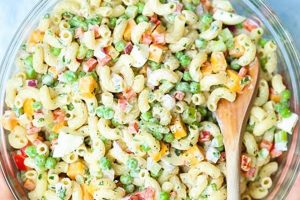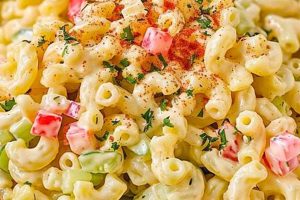This concept encompasses a wide range of variations on a classic dish, typically composed of cooked elbow macaroni, mayonnaise, and a blend of vegetables and seasonings. Examples include simple preparations with celery, onion, and sweet pickle relish, as well as more elaborate versions incorporating ingredients like hard-boiled eggs, shredded carrots, bell peppers, and different types of cheeses.
The adaptability of this dish contributes to its popularity. It can be served as a side at barbecues, picnics, and potlucks, or enjoyed as a light meal on its own. Its creamy texture and customizable flavor profile make it a crowd-pleasing option for diverse palates and dietary preferences. Historically, the dish gained traction with the increasing availability of prepared mayonnaise in the early 20th century, evolving from simpler pasta salads and becoming a staple in American cuisine.
The following sections will explore specific recipe variations, ranging from classic preparations to innovative interpretations, offering detailed instructions, ingredient lists, and tips for achieving optimal results. Additionally, nutritional information and suggestions for adapting recipes to accommodate dietary restrictions will be provided.
Tips for Exceptional Macaroni Salad
Achieving a perfect macaroni salad involves attention to detail and a few key techniques. The following tips offer guidance for creating a flavorful and well-balanced dish.
Tip 1: Cook Pasta Al Dente: Slightly firm pasta holds its shape better and prevents a mushy texture. Cook pasta according to package directions, reducing the cooking time by a minute or two for optimal firmness. Rinse cooked pasta under cold water to stop the cooking process and maintain a desirable texture.
Tip 2: Balance Flavors: A harmonious blend of flavors is crucial. Consider the sweetness of the dressing, the tanginess of vinegar or relish, the saltiness of seasonings, and the freshness of vegetables. Taste and adjust seasonings as needed to achieve a well-rounded flavor profile.
Tip 3: Choose High-Quality Ingredients: Fresh, high-quality ingredients elevate the final product. Select crisp vegetables, flavorful cheeses, and a good-quality mayonnaise or dressing base.
Tip 4: Chill Thoroughly: Chilling allows the flavors to meld and enhances the overall taste. Refrigerate the salad for at least two hours before serving to allow the ingredients to combine and the flavors to develop fully.
Tip 5: Add-ins for Texture and Flavor: Consider adding ingredients like chopped hard-boiled eggs, crumbled bacon, or toasted nuts for added texture and flavor complexity. These additions can complement the creamy base and provide contrasting elements.
Tip 6: Don’t Overmix: Gentle mixing prevents the salad from becoming overly creamy or the vegetables from breaking down. Combine ingredients carefully until just incorporated.
Tip 7: Proper Storage: Store leftover macaroni salad in an airtight container in the refrigerator for up to three days. Ensure the salad is chilled thoroughly before serving again.
By following these tips, one can create a macaroni salad that is both delicious and visually appealing. Attention to these details ensures a balanced flavor profile and a satisfying textural experience.
These culinary insights provide a solid foundation for preparing a variety of macaroni salads. The following section will offer concluding remarks and suggestions for further exploration.
1. Ingredients
Ingredient selection significantly impacts the final character of macaroni salad. The interplay of components defines the overall flavor profile, texture, and nutritional value. Consider the foundational element: pasta. Elbow macaroni is traditional, but other short pasta shapes, like rotini or shells, offer textural variations. The choice of mayonnaise influences richness and tang; some recipes incorporate plain yogurt or sour cream for a lighter alternative. Vegetables contribute crucial freshness and crunch; celery, onion, and bell peppers are common, while additions like shredded carrots or chopped pickles introduce nuanced flavors. Beyond these basics, ingredients like hard-boiled eggs, cheeses, herbs, and spices further diversify the possibilities. A classic macaroni salad might employ cheddar cheese, sweet pickle relish, and mustard, while a Mediterranean-inspired version might include feta cheese, olives, and oregano.
This understanding of ingredient interaction empowers informed choices. For example, substituting a milder vinegar for a sharper one can subtly shift the overall taste. Adding a pinch of sugar can balance acidity, while incorporating fresh herbs can elevate the aroma and complexity. Recognizing the role of each ingredient allows for creative experimentation and adaptation. A cook seeking a lower-fat option might opt for Greek yogurt instead of mayonnaise and increase the proportion of vegetables. Someone aiming for a spicier profile might incorporate diced jalapeos or a dash of cayenne pepper. The practical application of this knowledge lies in the ability to tailor the recipe to specific preferences and dietary needs.
Ultimately, ingredient awareness lies at the heart of successful macaroni salad creation. Understanding the contribution of each component allows for a deliberate and informed approach, enabling customization and ensuring a final product that aligns with desired flavor and texture objectives. This ingredient-focused perspective facilitates a deeper appreciation for the versatility and adaptability of this seemingly simple dish, paving the way for both classic renditions and innovative interpretations.
2. Variations
The concept of “all recipes macaroni salad” inherently implies a multitude of variations. This diversity stems from the dish’s adaptability and the wide array of ingredients that can be incorporated. Variations arise from ingredient substitutions, additions, and adjustments to the core recipe. These modifications cater to diverse palates, dietary restrictions, and culinary traditions. A classic American macaroni salad, for example, typically features celery, onion, and sweet pickle relish, while a German version might include cucumbers, potatoes, and a vinegar-based dressing. Regional influences play a significant role, with Southern variations often incorporating pimentos and hard-boiled eggs.
The practical significance of understanding these variations lies in the ability to tailor the recipe to specific needs and preferences. Dietary adaptations, such as substituting vegan mayonnaise or omitting gluten-containing pasta, exemplify this flexibility. Furthermore, exploring variations allows cooks to discover new flavor combinations and elevate the dish beyond its basic form. Adding different cheeses, such as feta or blue cheese, can introduce complexity, while incorporating fresh herbs or spices, like dill or paprika, can enhance the aroma and taste. The addition of proteins like grilled chicken or shrimp transforms the salad into a more substantial meal.
In essence, the breadth of variations underscores the versatility of macaroni salad. This adaptability allows the dish to transcend its simple categorization and become a canvas for culinary expression. From classic preparations to innovative interpretations, the spectrum of variations ensures that macaroni salad remains a relevant and adaptable dish across diverse culinary landscapes. This understanding empowers individuals to not only recreate traditional recipes but also to experiment and personalize, contributing to the ongoing evolution of this culinary staple.
3. Preparation Methods
Preparation methods significantly influence the final quality and character of macaroni salad. Understanding these techniques allows for greater control over texture, flavor development, and overall presentation. While the core concept remains consistent, variations in preparation methods contribute to the diversity encompassed by “all recipes macaroni salad.” These methods range from basic techniques suitable for simple preparations to more advanced approaches for complex variations.
- Pasta Cooking Technique
Proper pasta cooking is fundamental. Overcooked pasta results in a mushy texture, while undercooked pasta lacks the desired tenderness. The “al dente” method, where pasta is cooked until firm to the bite, is crucial for achieving optimal texture in macaroni salad. Rinsing the cooked pasta under cold water stops the cooking process and helps maintain firmness. This step prevents the pasta from sticking together and ensures a pleasant mouthfeel in the finished salad.
- Ingredient Incorporation
The order and method of incorporating ingredients affect both flavor and texture. Adding certain ingredients, like delicate herbs, towards the end of the preparation process preserves their freshness and prevents them from wilting. Gentle mixing ensures that ingredients are evenly distributed without crushing or breaking down more delicate components. This careful approach maintains the integrity of each ingredient and contributes to a visually appealing and texturally satisfying salad.
- Dressing Emulsification
Creating a stable and flavorful dressing is essential. For mayonnaise-based dressings, proper emulsification prevents separation and ensures a creamy texture. Whisking ingredients together thoroughly, or using a blender or food processor, creates a smooth and homogenous dressing that coats the pasta and other ingredients evenly. This contributes to a cohesive and flavorful salad.
- Chilling and Resting Time
Chilling the prepared salad allows flavors to meld and develop. Refrigeration for at least two hours enhances the overall taste and allows the ingredients to fully integrate. This resting period is particularly important for complex flavor profiles, allowing subtle nuances to emerge. Proper chilling also improves food safety by inhibiting bacterial growth.
Mastery of these preparation methods is crucial for achieving desired outcomes in macaroni salad preparation. From the foundational technique of cooking pasta al dente to the nuances of dressing emulsification and chilling, each step contributes to the final product’s quality. Consideration of these techniques empowers cooks to execute recipes effectively, resulting in a macaroni salad that embodies both flavor and textural excellence. This attention to detail distinguishes a well-prepared macaroni salad from a mediocre one, elevating it from a simple side dish to a culinary highlight.
4. Serving Suggestions
Serving suggestions contextualize macaroni salad within a broader culinary experience. Understanding these suggestions elevates the dish beyond a simple side and integrates it into diverse meal structures and social contexts. Effective serving suggestions consider factors such as complementary flavors, portion sizes, and presentation aesthetics. They enhance the dining experience by providing guidance on how best to enjoy macaroni salad within a wider culinary framework.
- Occasion-Based Serving
Macaroni salad’s adaptability lends itself to various occasions. Barbecues, picnics, and potlucks often feature macaroni salad as a refreshing and crowd-pleasing side dish. In more formal settings, smaller portions and elegant presentation elevate its role. The occasion dictates serving style, portion size, and accompanying dishes. A casual barbecue might warrant a large bowl served family-style, while a formal luncheon might call for individual portions plated with garnishes.
- Complementary Dishes
Pairing macaroni salad thoughtfully enhances the overall meal. Grilled meats, fried chicken, or sandwiches often complement its creamy texture and relatively mild flavor. Consideration of contrasting textures and flavors is key. The richness of macaroni salad can be balanced by the acidity of a vinegar-based slaw or the freshness of a green salad. The choice of complementary dishes creates a balanced and satisfying meal experience.
- Presentation and Garnishing
Presentation elevates the perceived value of any dish. Serving macaroni salad in an attractive bowl or platter enhances its visual appeal. Garnishes, such as fresh herbs, a sprinkle of paprika, or a scattering of chopped nuts, add visual interest and subtle flavor enhancements. Thoughtful presentation transforms a simple side into a more appealing culinary offering. A garnish of chopped chives can add a pop of color and a mild onion flavor, while a sprinkle of paprika can provide visual contrast and a hint of smokiness.
- Temperature Considerations
Serving temperature impacts the perceived flavors and textures of macaroni salad. While traditionally served chilled, some variations benefit from being served at room temperature, allowing certain flavors to become more pronounced. Understanding temperature’s influence optimizes the sensory experience. A chilled macaroni salad offers a refreshing contrast to hot grilled dishes, while a room-temperature version might better complement a cold sandwich platter.
These serving suggestions demonstrate that macaroni salad’s versatility extends beyond ingredient variations. By considering occasion, complementary dishes, presentation, and temperature, individuals can optimize the enjoyment of this classic dish. These considerations elevate macaroni salad from a simple side to a more integral component of a well-rounded and satisfying culinary experience, further highlighting its adaptable nature and enduring appeal.
5. Storage Techniques
Proper storage techniques are crucial for maintaining the quality and safety of macaroni salad, a dish particularly susceptible to spoilage due to its mayonnaise and vegetable components. Effective storage directly impacts the longevity and palatability of any macaroni salad variation, regardless of specific ingredients. Understanding these techniques is essential for preserving the dish’s freshness, flavor, and texture, ultimately maximizing its enjoyment and minimizing food waste.
The primary objective of proper storage is to inhibit bacterial growth and maintain optimal ingredient quality. Mayonnaise, a key component in most macaroni salads, is prone to spoilage at room temperature. Refrigeration at or below 40F (4C) significantly slows bacterial growth, extending the salad’s shelf life. Airtight containers prevent the salad from drying out and absorbing odors from other foods in the refrigerator. Prompt refrigeration after preparation is crucial, especially in warmer climates, to minimize the risk of foodborne illness. For instance, leaving macaroni salad at room temperature for extended periods, especially during outdoor events like picnics, can create an environment conducive to rapid bacterial growth, rendering the salad unsafe to consume.
Practical application of these storage techniques ensures food safety and preserves the desired sensory qualities of the salad. Properly stored macaroni salad retains its creamy texture, vibrant colors, and balanced flavors for up to three to five days. Beyond this timeframe, quality degradation becomes noticeable, with potential changes in texture, flavor, and safety. Freezing macaroni salad is generally not recommended, as the mayonnaise-based dressing can separate upon thawing, resulting in an undesirable texture. Understanding these limitations allows for informed decisions regarding preparation quantities and consumption timelines, ultimately minimizing waste and maximizing enjoyment. This knowledge empowers individuals to confidently prepare and serve macaroni salad, ensuring a positive culinary experience while adhering to food safety best practices.
6. Dietary Adaptations
Dietary adaptations represent a crucial aspect of “all recipes macaroni salad,” demonstrating the dish’s inherent flexibility and inclusivity. Adapting recipes to accommodate specific dietary needs expands accessibility and ensures that individuals with restrictions can enjoy this culinary staple. Understanding these adaptations requires consideration of ingredient substitutions, alternative preparation methods, and careful attention to potential cross-contamination issues. This knowledge empowers individuals to modify recipes confidently, preserving the essence of macaroni salad while adhering to specific dietary guidelines.
- Gluten-Free Adaptations
Gluten-free diets necessitate the substitution of traditional wheat-based pasta with gluten-free alternatives. Options include pasta made from rice, corn, quinoa, or legumes. Careful selection is crucial, as gluten-free pasta can exhibit different cooking properties and textures. Ensuring the chosen pasta holds its shape and maintains a desirable texture after cooking is essential for a successful gluten-free macaroni salad. Cross-contamination must also be considered; using dedicated cooking utensils and avoiding shared surfaces prevents accidental gluten exposure.
- Vegan Adaptations
Vegan diets exclude all animal products, necessitating careful ingredient substitutions. Traditional mayonnaise, a core component of macaroni salad, must be replaced with a plant-based alternative, such as vegan mayonnaise made from soy, aquafaba, or cashews. Furthermore, any other animal-derived ingredients, such as cheese or hard-boiled eggs, require plant-based substitutes. Nutritional yeast can mimic a cheesy flavor, while tofu can provide a similar texture to eggs. Careful attention to ingredient selection ensures a flavorful and satisfying vegan macaroni salad.
- Dairy-Free Adaptations
Dairy-free adaptations primarily focus on eliminating or substituting dairy-based ingredients. Replacing traditional mayonnaise with a dairy-free alternative, such as a plant-based mayonnaise or a dressing made with olive oil and vinegar, is crucial. If the recipe includes cheese, dairy-free cheese alternatives or nutritional yeast can provide similar flavors and textures. Ensuring that all ingredients are certified dairy-free prevents accidental exposure to lactose or other milk-derived components.
- Low-Fat/Low-Calorie Adaptations
Adapting macaroni salad for low-fat or low-calorie diets involves strategic ingredient substitutions and mindful portion control. Reducing the amount of mayonnaise or substituting it with plain Greek yogurt or a lighter vinaigrette significantly lowers fat and calorie content. Increasing the proportion of vegetables adds bulk and nutrients without significantly increasing calories. Using whole-wheat pasta enhances fiber content, promoting satiety. Careful attention to ingredient ratios and portion sizes allows for a satisfying and healthier version of this classic dish.
These dietary adaptations highlight the inherent versatility of macaroni salad. By understanding and applying these modifications, individuals can enjoy this classic dish regardless of dietary restrictions. This adaptability expands culinary inclusivity and reinforces the enduring appeal of macaroni salad across diverse dietary landscapes. Furthermore, these adaptations often lead to innovative flavor combinations and textural variations, enriching the culinary experience and demonstrating that dietary restrictions need not limit culinary creativity.
Frequently Asked Questions
This section addresses common inquiries regarding macaroni salad preparation, storage, and variations, providing concise and informative responses to enhance understanding and facilitate successful culinary endeavors.
Question 1: What is the best way to prevent macaroni salad from becoming too dry?
Adequate dressing is crucial. Adding a small amount of milk or plain yogurt to the dressing can enhance moisture without significantly altering the flavor profile. Ensuring the pasta is cooked al dente prevents excessive absorption of the dressing, maintaining a desirable texture.
Question 2: Can macaroni salad be frozen?
Freezing is generally not recommended. Mayonnaise-based dressings tend to separate upon thawing, resulting in an undesirable texture. Freezing can also negatively impact the texture of the vegetables, making them mushy upon thawing.
Question 3: How long can macaroni salad be stored in the refrigerator?
Properly stored in an airtight container, macaroni salad can be refrigerated for three to five days. Beyond this timeframe, quality degradation and potential bacterial growth become concerns.
Question 4: What are some suitable alternatives to mayonnaise in macaroni salad?
Plain Greek yogurt, sour cream, or a vinaigrette made with olive oil and vinegar offer lighter alternatives to mayonnaise. Vegan mayonnaise options, such as those made from soy, aquafaba, or cashews, cater to plant-based diets.
Question 5: How can one adapt macaroni salad for a gluten-free diet?
Substituting gluten-free pasta, such as those made from rice, corn, or quinoa, is essential. Ensure all other ingredients, including dressings and seasonings, are also gluten-free to avoid cross-contamination.
Question 6: What are some common variations on classic macaroni salad?
Variations often involve incorporating different vegetables, such as shredded carrots, bell peppers, or chopped pickles. Adding protein, like hard-boiled eggs, cooked chicken, or shrimp, transforms it into a heartier meal. Regional variations introduce ingredients like pimentos (Southern US) or potatoes and cucumbers (German).
This FAQ section offers essential insights for successful macaroni salad preparation and adaptation. Understanding these common inquiries empowers culinary exploration and ensures optimal results.
This concludes the comprehensive guide to all recipes macaroni salad. Experimentation and personalization are encouraged. Culinary creativity within the established framework can lead to innovative and satisfying results.
All Recipes Macaroni Salad
This exploration of all recipes macaroni salad has provided a comprehensive overview of this adaptable dish. From ingredient selection and preparation methods to variations, serving suggestions, storage techniques, and dietary adaptations, the multifaceted nature of macaroni salad has been thoroughly examined. Key takeaways include the importance of ingredient quality, the impact of preparation techniques on texture and flavor, and the vast potential for customization based on individual preferences and dietary needs. The adaptability of macaroni salad allows for both classic interpretations and innovative variations, ensuring its continued relevance in diverse culinary contexts.
Macaroni salad, often perceived as a simple side dish, possesses remarkable culinary depth. Its versatility allows for continuous evolution and personalization, reflecting diverse cultural influences and individual creativity. Further exploration of regional variations and innovative ingredient combinations promises to enrich culinary experiences and solidify macaroni salad’s enduring presence in the culinary landscape.






